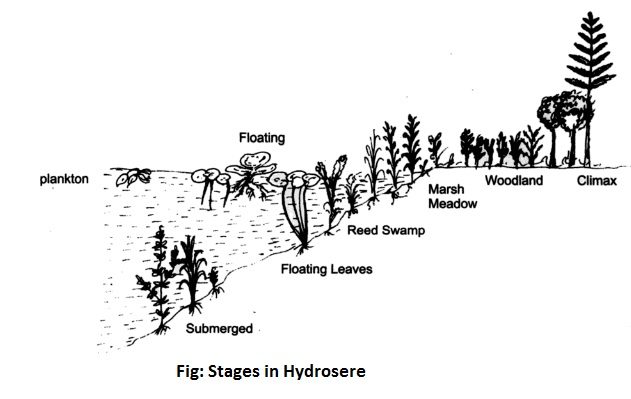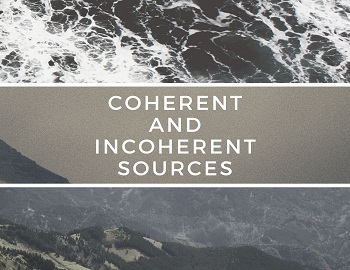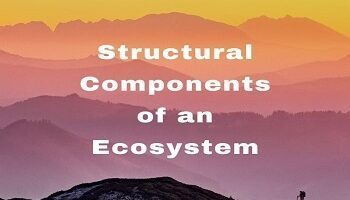Table of Contents
What is Biotic or Ecological Succession?
The biotic communities are not stable but undergo regular changes in a definite manner with the passage of time. Every community undergoes a series of changes until a group of organisms is established, which can live and reproduce most successfully in the area.
“The change of plant and animal community in an orderly sequence in an area, resulting in the establishment of a stable or climax community is called ecological or biotic succession.”
Biotic or ecological succession generally occurs in areas where plants would not normally grow due to the absence of soil nor the animals survive because of the absence of food and shelter. In such areas, the first biotic community is called the pioneer community. It is followed by a number of seral or transitional communities and finally the climax community.
Biotic or ecological succession starting on different types of areas or substrata are named differently as follows:
- Hydrosere or Hydrarch– starting in a watery area like a pond, swamp, bog.
- Mesarch– starting in an area of adequate moisture.
- Xerosere or Xerarch– starting in a dry area with little moisture. They can be of the following types-
- Lithosere– starting on a bare rock.
- Psammosere– starting on the sand.
- Halosere– starting on saline soil.
Characteristics of Ecological Succession:
- It is gradual and orderly progress towards a stable community.
- Its seral stages are so regular and directional that by examining a particular seral community, the sequence of future communities can be predicted.
- In successive seral stages, the species of organisms change along with the number of species.
- Succession occurs in both animal and plant communities side by side.
- From short lived plants to long lived plants.
- There is increase in biomass.
- Increased niche specialization.
- From lesser species diversity to higher species diversity.
- It progresses from simple food chain to complex food web.
- Formation of soil, increase in thickness and differentiation of soil.
- There is a gradual change from aquatic to dry conditions and then to mesic conditions.
Kinds of Ecological Succession:
Depending upon the nudity of area, biotic or ecological succession is of two types-
- Primary Succession or Prisere.
- Secondary Succession or Subsere.
Primary Succession or Prisere:
If succession begins on a newly constructed deposit of mineral sediment, it is called primary succession. Primary succession could happen on a sand dune, a sand beach, the surface of a new lava flow, or freshly fallen layer of volcanic ash or the deposits of silt on the inside of a river bend that is gradually shifting.
The sequence of successional stages of primary succession is called prisere. Primary succession takes a very long time to reach the climax stage.
Secondary Succession or Subsere:
If succession occurs on a previously vegetated area that has been recently disturbed, perhaps by fire, flood, wind-storm, or human activity, it is referred to as secondary succession.
The sequence of successional stages of secondary succession is called subsere. Secondary succession takes comparatively much less time to reach the climax stage.
Causes of Biotic or Ecological Succession:
There are three causes of biotic succession-
- Initial Causes– These include both climatic and biotic factors which destroy the existing population and make the area bare or naked for biotic succession.
- Continuing Causes– These include those events which support successful growth of a community in a bare area.
- Stabilizing Causes– These factors help in the stabilization of a community in an area by maintaining balance between the environment and community.
Process of Ecological Succession:
F.E.Clement (1916) developed a descriptive theory of succession and advanced it as a general ecological concept. His theory of succession had a powerful influence on ecological thought. Clement’s concept is usually termed classical ecological theory. According to Clement, succession is a process involving several phases-
Nudation:
It is the development of a bare area without any life form. The bare area may be caused due to landslides, volcanic eruptions, etc. (topographic factor) or due to drought, glaciers, frost, etc. (climatic factor) or due to overgrazing, disease outbreak, agricultural/ industrial activities (biotic factors).
Invasion:
It is the successful establishment of one or more species on a bare area through dispersal or migration, followed by ecesis or establishment. Dispersal of the seeds, spores, etc. is brought about by the wind, water, insects, or birds. Then the seeds germinate and grow on the land. As growth and reproduction start, these pioneer species increase in number and form groups or aggregations.
Competition and Coaction:
As the number of individuals grows there is competition, both inter-specific (between different species) and intra-specific (within the same species), for space, water, and nutrition. They influence each other in a number of ways, known as coaction.
Reaction:
The living organisms grow, use water and nutrients from the substratum, and in turn, they have a strong influence on the environment which is modified to a large extent and this is known as a reaction. The modifications are very often such that they become unsuitable for the existing species and favor some new species, which replace them. Thus, the reaction leads to several seral communities.
Stabilization:
The succession ultimately culminates in a more or less stable community called climax which is in equilibrium with the environment.
The climax community is characterized by maximum biomass and symbiotic (mutually beneficial) linkages between organisms and are maintained quite efficiently per unit of available energy.
Biotic or Ecological Succession on Bare Rock (Lithosere):

Xerosere is biotic succession that occurs in dry areas. One such area is a bare rock. Biotic or ecological succession occurring on a bare rock is called lithosere. Pioneers of this succession depend upon the climate. In tropical areas, the pioneers are cyanobacteria or blue-green algae. In temperate areas, they are crustose lichens.
Crustose Lichen Stage:
The pioneer’s colonizers on the bare rock are crustose lichens which occur on the rock surface in the form of membranous crusts. Their spongy nature enables them to absorb the excess amount of water and minerals. The lichens secrete lichen acid (oxalic acid) and produce carbonic acid (H2CO3). Both the acids cause etching of the rock surface creating small pores. The pores become gathering points for organic matter, dust particles, and water. Some common crustose lichens are Graphis, Rhizocarpon, and Lecanora.
Foliose Lichen Stage:
With time the rock surface becomes favorable for the growth of foliose lichens such as Parmelia, Dermatocarpon, Umbilicaria. These have large leaves-like thalli that overlap the crustose lichens and cause deeper depression and accumulation of more soil particles and humus in the rock.
Moss Stage:
With the accumulation of dust and humus, conditions become favorable for the growth of mosses. Their rhizoids penetrate deeper into the rocks and replace foliose lichens. Mosses accumulate more soil and organic matter and are able to retain moisture for a longer period and more moisture-loving mosses like Bryum, Hypnum, and Fissidems start growing. Among animals, nematodes, larval insects, ants, and mites also start living in that area.
Annual Grass Stage:
A number of xerophytic grasses and herbs reach the rock surface occupied by moss plants. Example- Poa, Eleusine, Festuca, Tridax. The grasses shade the mosses. Their roots penetrate deeper causing more weathering of the rock surface and building of more soil.
Perennial Grass Stage:
Annual grasses are replaced by perennial grasses like Themeda, Cymbopogon, Heteropogon, Solidago, and Potentilla. These grasses have runners and rhizomes and propagate rapidly. Several small animals and microbes are also attracted to live in this area.
Shrub Stage:
Hardy xerophytic shrubs invade the area occupied by perennial grasses. Example- Zizyphus, Capparis, Rubus, Fragaria, Zygophyllum, Rhus. Shrubs help in creating a soil profile and undergrowth. Biogeochemical cycles begin operating. Smaller shade tolerant herbs start growing below the shrubs.
Climax Forest:
With the establishment of the shrub stage more and more soil is formed and the environment becomes humid. This favors woody trees. In this way, a climax forest community is formed and a number of terrestrial vertebrates, ants, termites, earthworms, snails, grasshoppers, centipedes, millipedes, start living there.
The development of climax forest on bare rocks and sand dunes (primary succession) takes about 1000 years.
Biotic or Ecological Succession in Newly formed Pond or Lake (Hydrosere):

Plankton Stage:
In a new and virgin pond, hydrarch starts with the colonization of phytoplankton and zooplankton which constitute the pioneer community. The simple forms of life, such as bacteria, algae, and many other aquatic forms of plants (phytoplankton) and minute animals (zooplankton) floating in water are the pioneer colonizers. All these organisms add a large amount of organic matter and nutrients due to their various life activities and after their death, they settle in the bottom of pond to form a layer of silt.
Submerged Stage:
The plankton stage is followed by the submerged plant stage. The submerged plants, with their roots anchored in the mud, are next to colonize the pond. When these plants die their remains are deposited at the bottom of the ponds or lakes. This process gradually raises the bottom of the ponds and lakes up. As this process progresses, the body of water becomes more and more shallow, consequently the habitat becomes less suited for the submerged plants but more favorable for other plants.
Floating Stage:
Now the floating plant species invade the pond. In the beginning, the submerged and floating plants grow intermingled but in the course of time, the submerged plants are replaced completely. The most tolerant species in the area are able to reproduce and perpetuate. Due to continuous interaction between plant communities and the aquatic environment, the habitat becomes changed chemically as well as physically. More water and airborne soil and dead remains of plants are deposited at the bottom. Thus, the substratum rises up in a vertical direction. Important floating plants that replace the submerged vegetation are Nelumbo, Trapa Nymphaea, Pistia, Limnanthemum, etc.
Reed Swamp Stage:
It develops on shallow banks where the depth of water is 0.3 to 1.0 m. The plants are amphibious with the lower parts inside water while the upper part is aerial. Example- Typha, Scirpus, Phragmites, Sagittaria, Zizania, Alisma. The plants hold silt, generate a lot of organic matter, and transpire large quantities of water. They, therefore, raise the bottom.
Marsh Meadow or Sedge Stage:
When the water level is reduced to a few inches, several kinds of grass and sedges start growing. These include sedges like Carex, Cyperus, Juncus, and grasses like Themeda and Dichanthium. Herbs like Campanula, Caltha, Polygonum, etc. also appear. These plants also have a high rate of transpiration. As a result of water loss, the soil becomes dry and more suitable for woody plants.
Woodland Stage:
It consists of shrubs and small trees which can tolerate bright sunlight and waterlogged condition example- Salix, Cornus, Cephalanthus, Populus. The woodland stage lowers the water table. A lot of ground is shaded. As a result, several smaller plants requiring shade invade the area.
Climax Forest:
Slowly the woodland is replaced by a forest. The climax forest depends upon the climate of the area. Example- broad-leaved evergreen forest in a moist tropical area, deciduous forests in areas with seasonal rainfall, mixed forests in subtropical areas, and coniferous forests in a temperate area.
Importance of Biotic or Ecological Succession:
The ecological succession is of great practical importance in many activities of man-
- Ecological Succession provides information, which helps to have a controlled growth on one or more species in a forest by preventing the invasion of other species in the area.
- Pastures can be maintained by not allowing biotic succession to proceed further through grazing on fire.
- Ecological Succession also helps in reforestation and forest management programmes.









Comments (No)